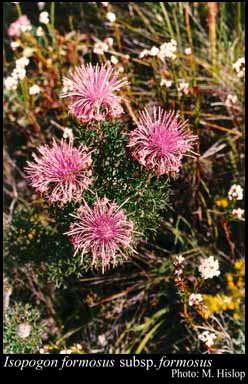- Conservation Code
- Not threatened
- Naturalised Status
- Native to Western Australia
- Name Status
- Current
Low, bushy or slender, upright, non-lignotuberous shrub, 0.2-2 m high. Fl. pink-purple/red, Jul to Dec. White/grey or yellow sand, sandy soils over laterite or granite. Undulating sandplains, outcrops, rocky rises, seasonally swampy sites.







Scientific Description
Shrubs, 0.5-2 m high; branchlets glabrous or hairy, with straight hairs or with curled hairs. Leaves alternate, 25-65 mm long, glabrous; lamina terete or flat, twice or more divided, pinnately divided or tripartitely divided, divided to the midrib, with (3-)8-16(-22) points or lobes; distance from base of leaf to lowest lobe 14-50 mm. Inflorescences not viscid, red or pink. Perianth 18-31 mm long, hairy, the limb apex hairy at the apex only; pistil 18-31 mm long; pollen presenter not fusiform, hairy, 4-6.5 mm long, the brush 1-2 mm long. Cone with deciduous scales, 15-20 mm long. Flowers in May, July, August, September, October, November or December. Occurs in the South-west (SW) Botanical Province(s), in the Avon Wheatbelt (AW), Jarrah Forest (JF), Mallee (MAL), Warren (WAR) or Esperance Plains (ESP) IBRA subregion(s).
Distribution
- IBRA Regions
- Avon Wheatbelt, Esperance Plains, Jarrah Forest, Mallee, Warren.
- IBRA Subregions
- Eastern Mallee, Fitzgerald, Katanning, Recherche, Southern Jarrah Forest, Warren, Western Mallee.
- IMCRA Regions
- WA South Coast.
- Local Government Areas (LGAs)
- Albany, Cranbrook, Denmark, Esperance, Gnowangerup, Jerramungup, Kojonup, Plantagenet, Ravensthorpe.